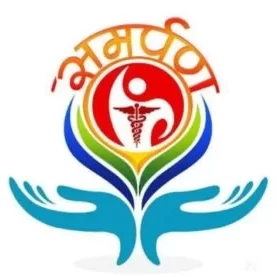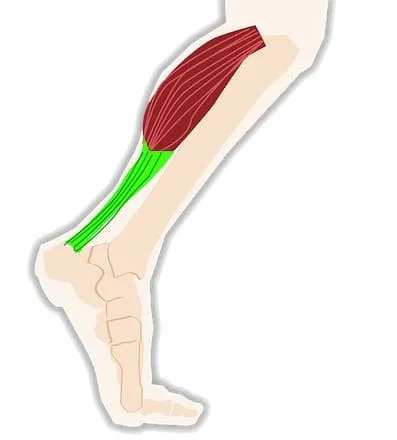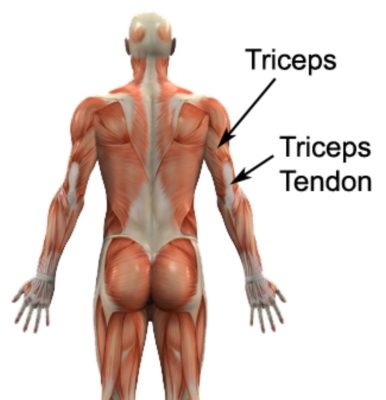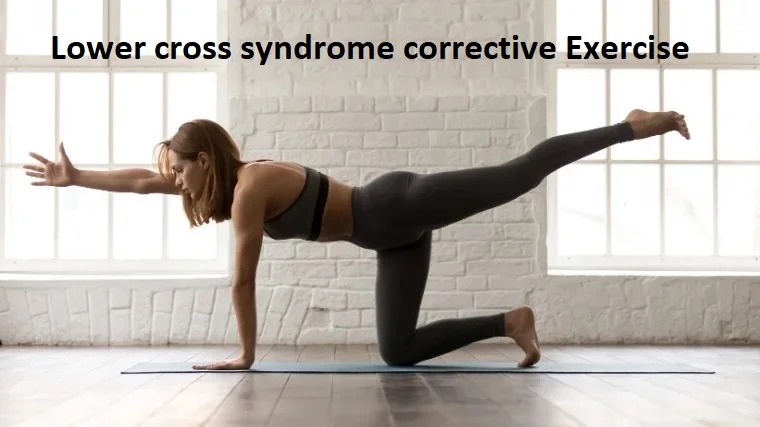5 Best Yoga For Hyperlordosis
Table of Contents
Introduction
Yoga can help by strengthening the core, stretching tight hip flexors, and improving overall posture. Gentle, targeted poses encourage spinal position and relieve lower back pain, making yoga a valuable tool in managing and correcting Lumbar hyperlordosis naturally.
What is Hyperlordosis?
Poor pelvic posture is a contributing factor in certain individuals. The lower back’s curvature is impacted when the pelvis tilts too far forward, giving the impression that the individual is protruding their butt. While a slight lordosis is typical, an excessive curve over time may become problematic.
Causes of Hyperlordosis
The only way to effectively manage and treat hyperlordosis is to understand its underlying causes. Hyperlordosis has several causes, including:
- Spinal abnormalities: Achondroplasia and spondylolisthesis are two examples of spinal irregularities that can produce hyperlordosis because they substantially alter the spine’s natural position.
- Slouching: The lower back muscles are frequently subjected to recurrent strain due to poor posture, particularly regular slouching. Over time, as the muscles attempt to stabilize the spine, this recurrent tension causes tightness. It consequently curves in addition to of its normal range, which may result in stiffness or back pain.
- Obesity: The lumbar spine is squeezed by extra body fat, in particular the abdominal area.
- Absence of Exercise: The postural protective muscle group may become less able to adequately support the spine due to a sedentary lifestyle and weak core muscles. Because of this, even with little pressure or movement, the spine is more likely to have excessive curvature.
Symptoms of Hyperlordosis
Numerous symptoms caused by hyperlordosis adversely influence a person’s everyday life and general health.
- Lower Back pain: One of the most prevalent complaints is persistent lumbar cramping.
- Hip Pain: Tightness or cramping in the hip region may result from muscular imbalances.
- Muscle Fatigue: When joining in outdoor activities, overworked muscles may become exhausted.
- Modified Gait: Pain or tenderness may cause alterations in gait.
The 5 best yoga poses for correcting hyperlordosis and improving posture:
Cat-Cow Stretch
- your palm and knee, supporting the tips of your fingers over your shoulders and your knees, extending your hips. Focusing on the line going through the tailbone before returning to the closest part of the head. This posture has a neutral spine.
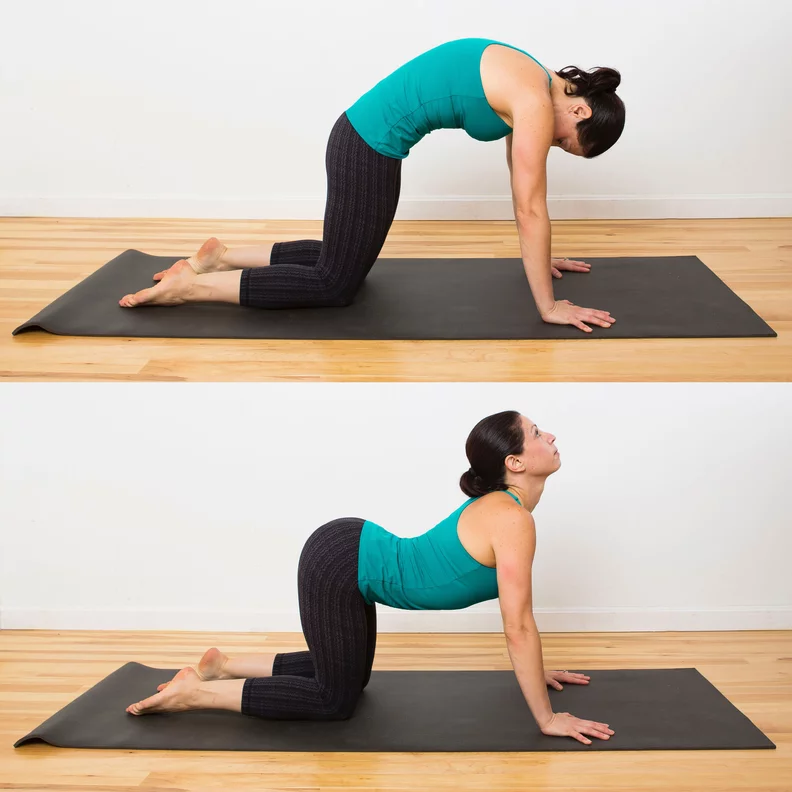
Child’s Pose (Balasana)
- Place your forehead on a block or two folded fists if placing it on the floor causes pain. The vagus nerve is stimulated, and a “rest and digest” response is supported by an energy point located in the middle of the forehead, between the eyebrows.
- You can either pull your arms back beneath your thighs with your palms facing up or extend them in front of you with your hands facing the floor. In this position, the elbows should be thrust forward.
- Reconnect with your breath’s regular inhalations and exhalations as long as you like.
- Start by lying down in the correct position. You might want to lie down on a yoga mat if you have one.
- Maintaining a hip-width gap between your feet, place them near your hips while bending your knees.
- Check that the soles are parallel to the knees and that your fingertips make contact with the heels.
- Use the Iyengar yoga props as described above, keeping them within easy reach.
- Make sure your shoulders and spine are in alignment by utilizing a bolster or yoga block.
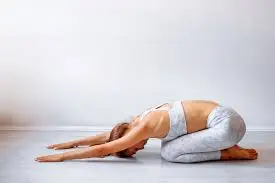
Plank Pose (Phalkasana)
- On a non-slip yoga mat, assume the position known as Uttanasana, or Standing Forward Bend. As soon as possible, make your entire body, from head to heels, as long and straight as a piece of wood.
- Make sure you are actually on the balls of your feet by adjusting the distance between your hands and feet.
- As you stretch through your heels, raise the tops of your thighs.
- Be careful not to slump through the shoulders or sink your hips.
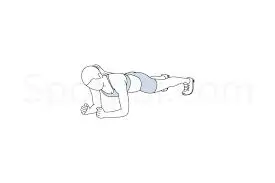
Seated Forward Bend (Paschimottanasana)
- pushing toward the ceiling with your arms extended to the bend and up over your head.
- Deepen into your forward bend with each exhale. You may maintain a long spine by doing this.
- Don’t bend your neck to gaze up or let it go entirely; instead, keep it as the natural extension of your spine.
- Choose whether to remain in this position or allow your spine to round forward once you have reached your maximum extension with the spine long.
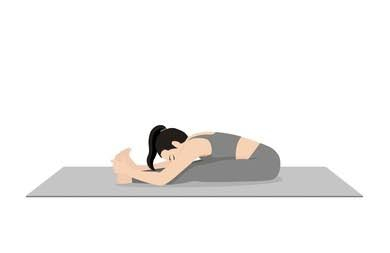
Bridge Pose(Setu Bandhasana Sarvangasana)
- Lie on your back, thighs stretched, feet on the mat, hip distance apart. Get your feet as in proximity to your glutes as possible.
- Place your arms against your body, palms down.
- Push your upper arms down. You can place your hands across your back and press your pinky fingers into the mat.
- Continue to press down hard with your heels and squeeze your thighs together to keep them hip-distance apart.
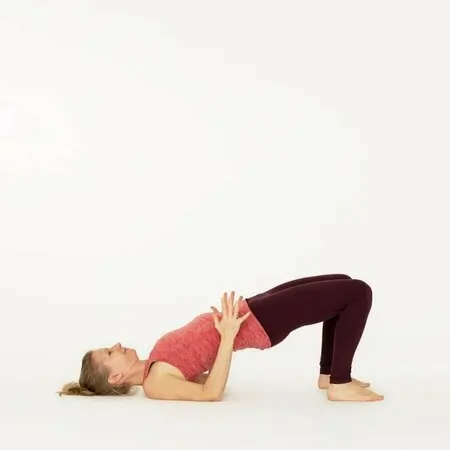
5 Best Yoga Videos for Hyperlordosis Video
Safety Considerations
As with any stretches and workouts, it’s crucial to start slowly. Initially, you might not be able to stretch as far as you would like, or you might only be able to perform a few repetitions. Gradually increase the number of repetitions and the depth of the stretches.
These workouts aren’t supposed to induce back pain; they’re supposed to relieve it. Limit the amount of repetitions or take a break if you experience pain.
Try cold packs or nonsteroidal anti-inflammatory medicines (NSAIDs) to relieve any pain if it worsens after performing these activities. See your doctor if the pain persists after trying anti-inflammatory medications, applying ice, and resting. Speak with your physician if you experience any pain when attempting to straighten your back fully.
Summary
Although the illness can be inherited, certain lifestyle variables are probably the cause when it manifests in maturity. Regular physical activity and a healthy weight can often decrease lower back pain and posture difficulties. Before diagnosing a condition and developing an individual treatment strategy, a physician will do a spine examination.
FAQs
Which yoga poses are beneficial for hyperlordosis?
Posture problems and discomfort result from this. As a result, one should engage in activities that target tight muscles and core strengthening. Therefore, one can perform exercises such as planks, bridge posture, child pose, cobra pose, pelvic tilt, spinal flexion and extension, knee-to-chest stretch, and hamstring stretch.
Is it possible to correct hyperlordosis?
Yes, exercises and lifestyle modifications can help correct hyperlordosis:
When standing, try to keep your posture straight and avoid bending your lower back too much.
Make adjustments to your sleeping and sitting postures.
Engage in activities that strengthen weak muscles and stretch tight ones.
Make an effort to keep your weight in check. You also seek a physiotherapist’s assistance.
Which muscles in hyperlordosis are weak?
Core muscles, hamstrings, glutes, hip extensors, lower back muscles, or pelvic floor muscles are the most frequently targeted muscles for hyperlordosis in most people.
Is hyperlordosis a chronic condition?
The disorder known as hyperlordosis is not irreversible. In most cases, it can be corrected or fixed with the aid of appropriate procedures. Proper workouts that target the affected muscles can help control the issue. Ergonomic chairs and supporting pillows are useful tools for maintaining proper posture when sitting and sleeping, respectively.
References
- Freutel, N. (2019, April 17). Core and hip exercises to correct lordosis posture. Healthline. https://www.healthline.com/health/fitness-exercise/lordosis-exercises
- Lillis, C. (2021, November 22). What to know about hyperlordosis. https://www.medicalnewstoday.com/articles/321959
- WebMD Editorial Contributor. (2025, February 1). Best exercises for hyperlordosis. WebMD. https://www.webmd.com/back-pain/best-exercises-hyperlordosis
